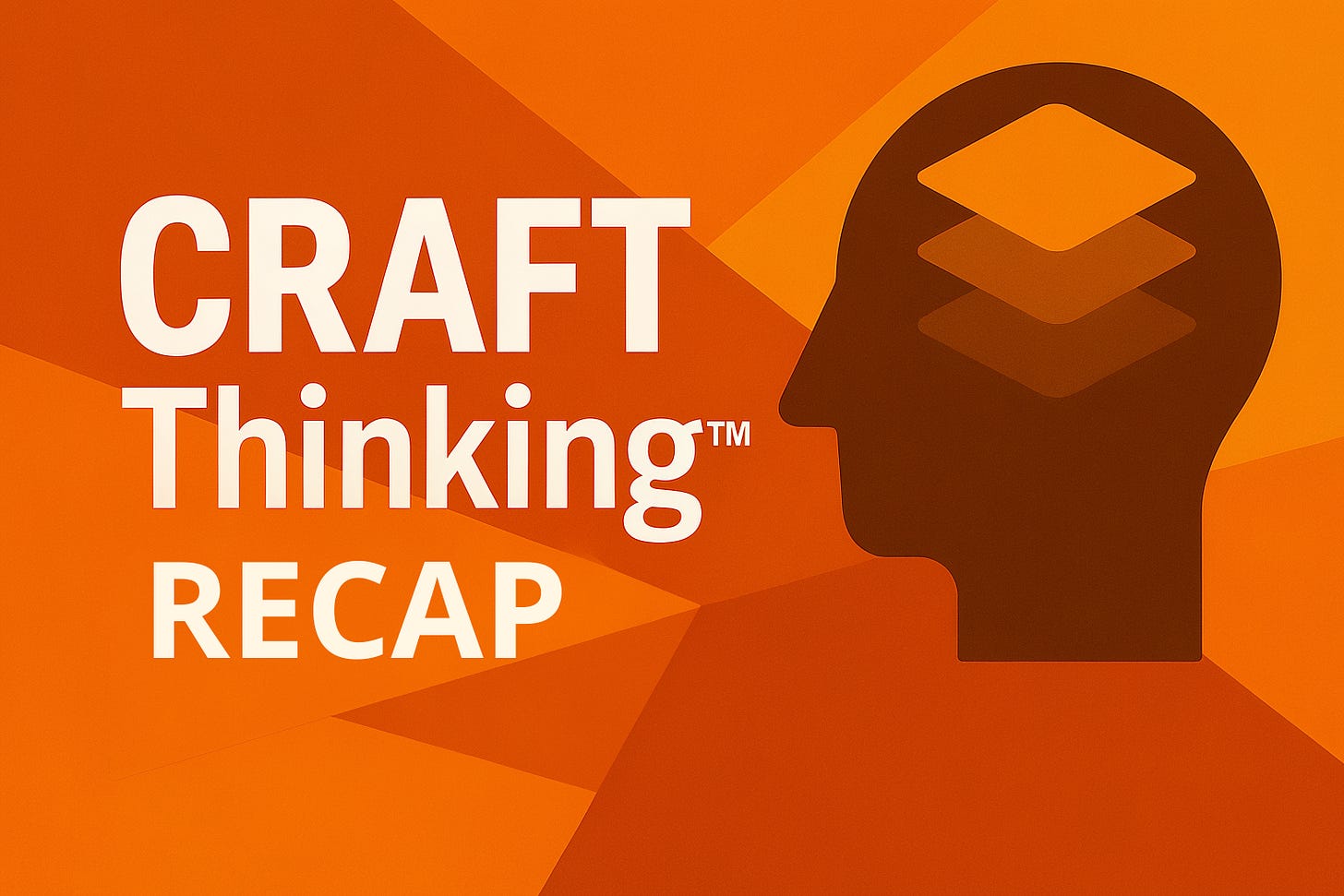Over the past year, we’ve explored CRAFT Thinking™ — a five-step framework for using AI not just to get answers, but to think better.
It’s grown from a simple way to structure prompts into a strategic method for decision-making, innovation, and foresight.
This recap covers the entire journey: Hindsight, Insight, Foresight, and Advanced CRAFT.
Why CRAFT Exists
Most people approach AI like a vending machine: insert a request, get an output.
But when your role is to make decisions, shape strategy, or create something new, AI works best as a thought partner — and that requires structure.
CRAFT Thinking™ is that structure:
C — Context: Give the model the background and situational details.
R — Role: Assign a perspective or stakeholder lens.
A — Action: Specify the high-leverage step you want next.
F — Format: Choose an output shape that sharpens thinking.
T — Target: Define the audience and the future impact you want.
Hindsight — Level 1: The Basics
In the early articles, we focused on mastering the basics of structured prompting.
This is where you learn to get clear, relevant, and useful outputs instead of generic ones.
Start here: [URL to Part 1]
Then read: [URL to Part 2] → [URL to Part 3] → [URL to Part 4] → [URL to Part 5] → [URL to Part 6] → [URL to Part 7] → [URL to Part 8]
Insight — Level 2: Adding Edges and Depth
Once you can prompt with structure, the next step is to go deeper:
Explore implications and second-order effects.
Surface blind spots.
Look for what’s missing, not just what’s present.
Read the Insight series here: [URL to Insight Series]
Foresight — Level 3: Thinking Ahead
At the highest foundational level, we use AI for scenario-building and preparedness:
Simulate future conditions.
Anticipate behavioral shifts.
Stress-test strategies against change.
Read the Foresight series here: [URL to Foresight Series]
Advanced CRAFT — Beyond Prompting
Advanced CRAFT shifts from prompting AI well to thinking with AI effectively.
Each element gets upgraded:
Advanced C: Clarity before Context — set your intention before you give background. [URL to Advanced C]
Advanced R: Role as Lens, not just Hat — choose perspectives that shape the conversation, including fringe or contrarian ones. [URL to Advanced R]
Advanced A: Action as Strategic Leverage — focus on the moves that matter, not just tasks. [URL to Advanced A]
Advanced F: Format as Cognitive Tool — use structure to reveal patterns and decisions. [URL to Advanced F]
Advanced T: Target as Future Impact — define the change you want to cause, not just the audience. [URL to Advanced T]
Meta-C: The Self-Aware Prompt — teach AI to evaluate your prompts and help you improve them over time. [URL to Meta-C]
CRAFT isn’t a checklist — and it never was.
Over this series, you’ve seen CRAFT in action: Context, Role, Action, Format, Target. It’s easy to mistake those as blanks to be filled in. That’s not the point.
CRAFT is a thinking framework — a lens you use to shape your conversations with AI.
If you approach it mechanically, you’ll get mechanical results.
If you approach it as a way of thinking — deliberately setting context, choosing roles, selecting high-leverage actions, shaping formats, and aiming for impact — you’ll get clarity, insight, and foresight you can’t reach otherwise.
Meta-C just makes that habit stick, by reflecting your prompts back to you and helping you refine them in real time.
The more you use it, the less you’ll think about “filling in the steps” — and the more you’ll just think this way.
An Anecdote: Why This Matters
I can’t count how many times someone has asked me, once they realize I’m “the AI person”:
“Can you create a recommended learning path for me?”
Sure — I could just hand them a prompt, and I’d probably use CRAFT to make it solid.
But here’s the thing: the prompt itself isn’t the goal. The skill comes from using AI yourself — experimenting, refining, and figuring out what works for you.
It’s like learning to ride a bike. You only develop balance by pedaling, wobbling, and adjusting.
Without that practice, prompting is just like someone putting you on a bike, towing you behind their car, and before you know it, you’re at your destination — but you never learned how to ride.
CRAFT Thinking™ is the frame, gears, and brakes. You still have to steer. And once you do, you’re no longer just prompting — you’re co-thinking.
The Core Truth
Prompting alone is not thinking.
CRAFT Thinking™ is the bridge from asking to understanding, from telling AI what to say to using AI to help you decide what needs to be said.
If you master this, you don’t just get better AI outputs.
You become a better thinker.
✦ Explore more with Craft Thinking — a space for frameworks, tools, and reflections on how to think and create with clarity.



